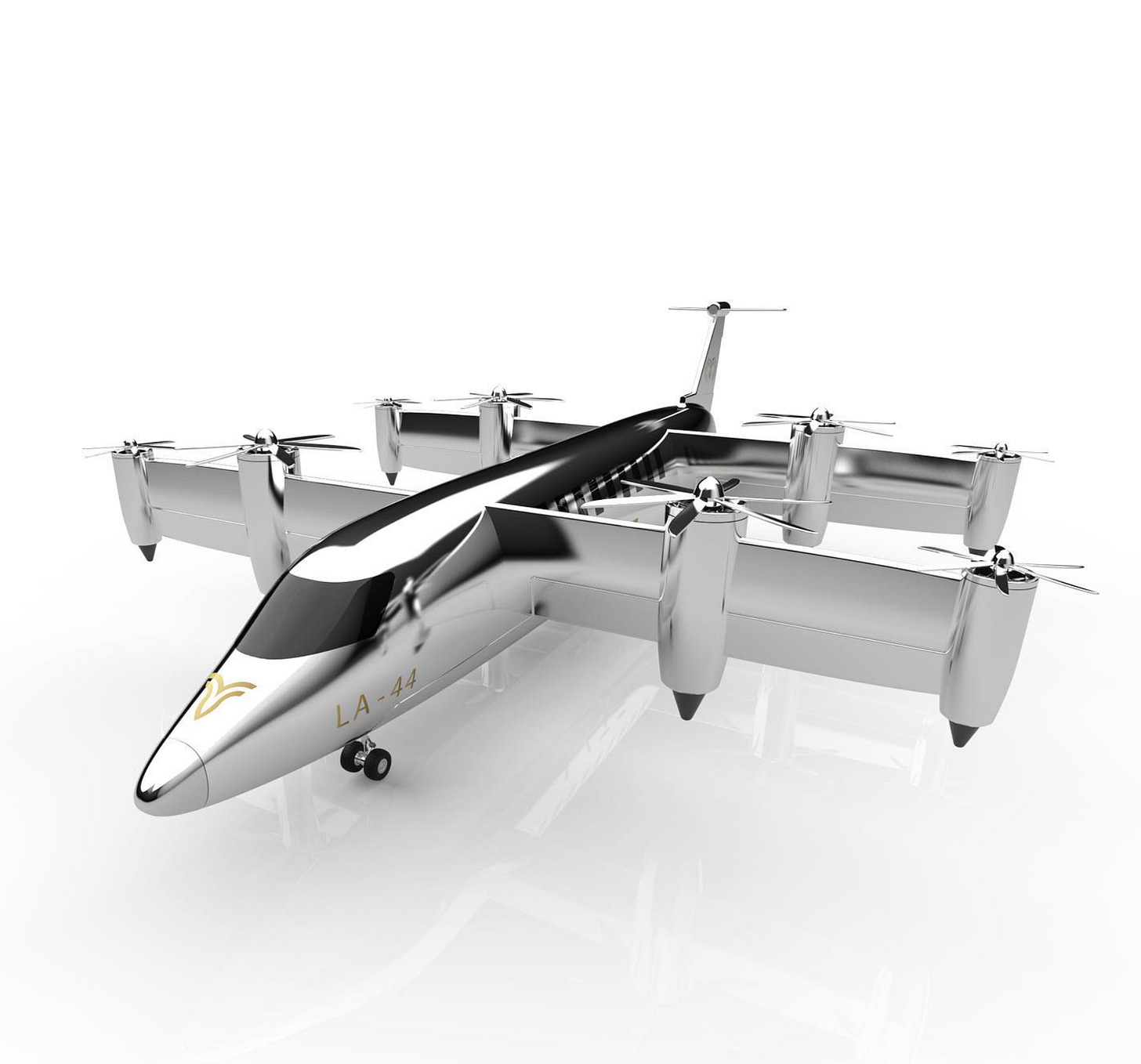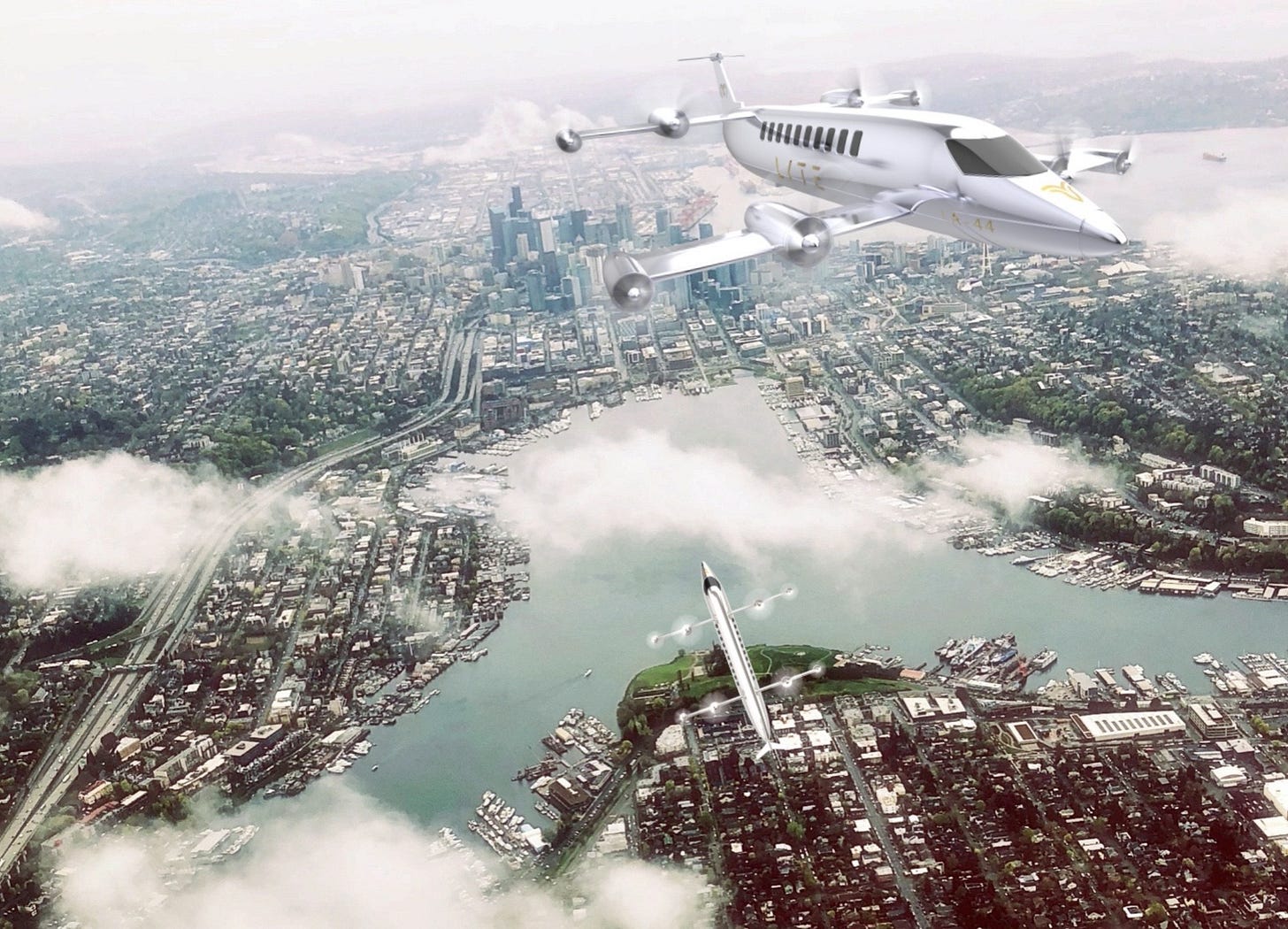From retro inspiration to futuristic mobility: LYTE Aviation's SkyBus
In conversation with Freshta Farzam, the Founder and CEO of UK and Germany-based LYTE Aviation.
Summary
LYTE Aviation is developing a 44-seat hybrid hydrogen-electric aircraft called the LA-44 ‘SkyBus’. It aims to revolutionise air transportation by carrying a significantly larger number of passengers than traditional eVTOLs (electric vertical takeoff and landing aircraft).
The inspiration for the SkyBus comes from the Fairey Rotodyne, a 1950s aircraft that combined helicopter and aeroplane capabilities. In contrast to the Rotodyne, LYTE's eVTOL will have low emissions, cost-effective operation, and minimal noise pollution in urban areas.
LYTE believes the SkyBus can serve a wide range of use cases due to its capacity of 44 passengers, its 1000 km range, and the fact that it only needs a vertiport, not a runway. It could also eliminate the need for train tracks and highways in remote areas, preserving the environment.
The initial use case presented by LYTE focuses on the greater Seattle area, where the SkyBus could offer an alternative to ferry and tollway commuting, saving time, reducing CO2 emissions, and alleviating stress for daily commuters.
Despite the significant financial investment required, LYTE is confident of the business case due to the revenue potential of disrupting the regional aviation and transportation market. LYTE is also developing a cargo version of the aircraft called the SkyTruck, with plans to introduce both aircraft within the current decade.
A 1950s aircraft as inspiration for a new eVTOL concept
Critics of eVTOLs argue that these upcoming ‘electric air taxis’, set to debut in 2025, won't actually reduce the number of cars on the road.
They claim that with their limited capacity of only four passengers, literally thousands of these eVTOLs would be required to fill city skies – an implausible scenario, to say the least.
But what if an eVTOL could carry over forty passengers? What if it could not only compete with cars but also buses, ferries, and other fossil fuel-powered means of transportation?
This is the grand vision of Freshta Farzam, the Founder and CEO of UK and Germany-based LYTE Aviation. Her company is currently developing a 44-seat hybrid-hydrogen-electric aircraft called the 'SkyBus.' Drawing inspiration from the Fairey Rotodyne, an aircraft design from the 1950s, LYTE aims to bring to life the concept of a large-capacity eVTOL.
With only one prototype ever built, the Fairey Rotodyne was an idea ahead of its time. It was a hybrid aircraft – a helicopter that could fly like an aeroplane, the eVTOL of its day. It had a big rotor on top, but it also had propellers on the wings that helped it fly forward. This allowed it to take off and land vertically like a helicopter and also fly long distances like an aeroplane.
In a wonderfully retro 1950s promotional film reminiscent of post-war British Pathé newsreels, a narrator talks about the Fairey Rotodyne “revolutionising medium range air transport” as the world’s “first vertical takeoff airliner… flying direct from the city centre to city centre”, and being able to take off and land in a space only a little bigger than the aircraft itself.
Interest in the aircraft was high, including from British Airways' forerunner, British European Airways (BEA), which wanted to create a ‘BEA bus’.
Unfortunately, the Rotodyne was so loud that John Farley, later chief test pilot for the vertical takeoff and landing Hawker Siddeley Harrier fighter jet, claimed that the noise from the engines could stop conversations two miles away. Running these aircraft in city centres was obviously a non-starter. It never went into production.
Meeting the needs of 21st century travel
Fast forward to today. Farzam is reimagining the concept of the Skybus to meet the needs of the twenty-first century.
By incorporating hybrid hydrogen-electric propulsion systems, the Skybus will boast low emissions. Like other next-generation aircraft, it will be more cost-effective to operate than its fossil fuel counterparts.
Additionally, its electric motors will ensure minimal noise pollution, making it an exceptionally quiet mode of transport in urban areas.
LYTE went public with its plans in early 2023, after being in stealth mode for over three and a half years. Farzam says that the team spent that time evaluating the eVTOL space. Their conclusion was that the market is open for disruption.
“This gave us the confidence to go ahead with, first of all, a twenty-seater,” Farzam says. But they realised that only carrying twenty passengers was far too limiting. They needed to make it “like a bus or a train”, with a capacity of at least 40 passengers.
The intended range of LYTE’s Skybus will be a reasonably significant 1000 km. Due to current battery technology limitations, an all-battery-electric solution was deemed impractical.
LYTE also determined that relying on hydrogen fuel cells alone wasn't viable, as the necessary technology wasn't yet market-ready. The initial design is outlined in a white paper: four conventional turbines running on jet fuel, fitted to burn sustainable aviation fuel (SAF), alongside four electric motors at the wing tips powered by hydrogen fuel cells.
Farzam says that LYTE has identified countless use cases for the SkyBus. For example, she explains that in many remote areas of Texas the maintenance costs (for transport infrastructure) “are so high that they are not even investing in roads”.
In fact, LYTE believes it will remove the need to lay train tracks and highways in remote locations, thereby saving local environments and natural habitats.
Farzam says the company also looked at the Caribbean, island nations like the Bahamas, places broken up by natural barriers such as the sea, “where people want to get from A to B, but they don’t have the runway space.”
Redefining commuting in the Greater Seattle Area and beyond
Interestingly, LYTE’s first published use case (put together with the help of the Advanced Air Mobility Institute (AAM)) looks at the greater Seattle area.
The waterways in the Seattle area have resulted in multiple ferry routes used by commuters. LYTE has scoped out a sample route from Bainbridge Island, on the other side of Seattle, to Redmond, the site of the Microsoft headquarters with 53,000 employees.
"The greater Seattle area is a fantastic use case to benefit daily commuters because the Bainbridge Island ferry across the Puget Sound to downtown is the 2nd busiest in the United States,” argues AAM President and Founder Dan Sloat.
Sloat says that LYTE’s Skybus would provide a realistic alternative to a combination of ferry and tollway driving which saves time, CO2 emissions, and stress.
In LYTE's whitepaper, we are introduced to a fictional Microsoft executive named Laine Barker to illustrate the benefits:
Barker's commute from a LYTE vertiport on Bainbridge Island to the Microsoft headquarters saves her 467.7 hours annually compared to taking the ferry and driving by car. Considering the Bainbridge Ferry transports 2500 cars each day, LYTE estimates that the SkyBus could potentially reduce CO2 emissions by up to 10,000 metric tonnes if a majority of these passengers choose the SkyBus instead.
Investors will help create something “next level”
The vision is undeniably impressive. However, based on our experience at SimpliFlying and while working on our upcoming book, 'Sustainability in the Air', we've witnessed numerous remarkable ideas fall by the wayside for one reason — lack of capital.
Consider this: it easily takes $1+ billion to develop a completely new aircraft. Farzam acknowledges a similar total need for LYTE. However, she says initial investors and partners haven’t flinched at that.
That’s because when you look at legacy aircraft companies like Boeing or Airbus, “one or two billion that we invest today into aircraft is quite accepted” based on “the revenues that they actually generate.” And here, the range and capacity of LYTE’s aircraft open up a lot of opportunities.
“We’re actually creating the next regional aviation or transportation modality. This is really disruptive. Next level.”
In addition to the SkyBus, LYTE is developing a cargo version of the aircraft called a SkyTruck. The aim is to have both aircraft flying before the end of the decade.
Our take
The vision is compelling; the use cases are practical and logical. Assuming the technology functions as intended and sufficient funding is secured, the SkyBus has the potential to be truly transformative.
It could revolutionise commuter routes in cities like Seattle, provide inter-island transportation in the Caribbean or in the Far East, and connect towns without airports to major international hubs, thanks to its 1000 km range and vertiport capabilities.




